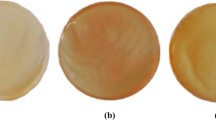Abstract
In the present study, wound dressing films were fabricated using Seed Husk of Psyllium (SHP) complexed with povidone iodine and were evaluated for various physicochemical properties as well as wound healing activity in albino rats. The required film properties for the successful wound dressings, such as film elongation (elasticity), tensile strength, water uptake and water vapor transmission rates (WVTR) were examined. Results indicated that SHP films showed good elasticity (80.27–116.24%) and acceptable tensile strengths (8.33–22.13 N/mm2). SHP films were evaluated for water absorption pattern as well as permeation to water vapours and results showed that films were able to swell in water upto 167 to 191% w/w and WVTR were in the range between 8.23 × 10−3 to 1.12 × 10−4 g.cm2/day. Selected formulation of SHP films with optimum characteristics were loaded with Povidone iodine (PI) solution by soaking method and were evaluated for antimicrobial and wound healing activity on excision wound model. Results indicated that PI loaded films showed significant antibacterial activity against both gram positive and gram negative selected bacteria. PI loaded SHP films showed comparatively better wound healing property to control group with faster epithelialization and greater rates of wound contraction.





Similar content being viewed by others
References
Agarwal M, Srinivasan R, Mishra A (2002) Synthesis of plantago psyllium mucilage grafted polyacrylamide and its flocculation efficiency in tannery and domestic wastewater. J Polym Res 9:69–73
Boateng JS, Matthews KH, Stevens HN, Eccleston GM (2008) Wound healing dressings and drug delivery systems: a review. J Pharm Sci 97:2892–2893
Cardoso SM, Ferreira JA, Mafra I, Silva AMS, Coimbra MA (2007) Structural ripening-related changes of the arabinan-rich pectic polysaccharides from olive Pulp cell walls. J Agric Food Chem 55:7124–7130
Cummings JH (1993) The effect of dietary fiber on fecal weight and composition. In: Spiller GA (ed) Dietary fiber in human nutrition, 2nd edn. CRC, Boca Raton, pp 263–349
Cutting K, White RJ (2002) Maceration of the skin and wound bed 1: its nature and causes. J Wound Care 11:275–278
Fischer HM, Nanxiong Y, Ralph RGJ, Andersond L, Marletta JA (2004) The gel-forming polysaccharide of psyllium husk (Plantago ovata Forsk). Carbohydr Res 339:2009–2017
Gohel MC, Amin AF, Chhabaria T, Panchal MK, Lalwani AN (2000) Modulation of drug release rate of diltiazem-HCl from hydrogel matrixes of succinic acid-treated Ispaghula husk. Pharm Dev Technol 5:375–381
Gohel MC, Patel MM, Amin AF (2003) Development of modified release diltiazem HCl tablets using composite index to identify optimal formulation. Drug Dev Ind Pharm 29:565–574
Krammer H, Schlieger F, Singer MV (2005) Therapeutic options of chronic constipation. Internist (Berl) 46:1331–1338
Kulkarni AR, Kulkarni VH, Keshavayya J, Hukkeri VI, Sung HW (2005a) Anti-microbial activity and film characterization of thiazolidinone derivatives of chitosan. Macromol Biosci 5:490–493
Kulkarni VH, Keshavayya J, Shastry CS, Kulkarni PV (2005b) Transdermal delivery of antiasthmatic drug through modified chitosan membrane. Indian J Pharm Sci 67:544–547
Lee KH, Tong TG (1968) Study on the mechanism of action of salicylates, retardation of wound healing by aspirin. J Pharm Sci 57:1042–1046
Morton JJP, Malon MH (1972) Evaluation of vulnerary activity by an open wound procedure in rats. Arch Int Pharmacondyn 176:117–26
Muzzarelli R, Weckx M, Fillippini O, Lough C (1989) Characteristic properties of N-carboxybutyl chitosan. Carbohydr Polym 11:307–320
Muzzarelli R, Tarsi R, Filippini O, Giovanetti E, Biagini G, Varaldo PE (1990) Antimicrobial properties of N-carboxybutyl chitosan. Antimicrob Agents Chemother 34:2019–2023
Saghir S, Iqbal MS, Hussain MA, Koschella A, Heinze T (2008) Structure characterization and carboxymethylation of arabinoxylan isolated from Ispaghula (Plantago ovata) seed husk. Carbohydr Polym 74:309–317
Sibbald GR, Orsted H, Schultz GS, Coutts P, Keast D (2003) Preparing the wound bed: focus on infection and inflammation. Ostomy Wound Manag 49:24–51
Singh B, Nirmala C (2009) Modification of psyllium polysaccharides for use in oral insulin delivery. Food Hydrocolloids 23:928–935
Van Rosendaal GM, Shaffer EA, Edwards AL, Brant R (2004) Effect of time of administration on cholesterol-lowering by psyllium: a randomized cross-over study in normocholesterolemic or slightly hypercholesterolemic subjects. Nutr J 28:17–24
Author information
Authors and Affiliations
Corresponding author
Rights and permissions
About this article
Cite this article
Patil, B.S., Mastiholimath, V.S. & Kulkarni, A.R. Development and evaluation of psyllium seed husk polysaccharide based wound dressing films. Orient Pharm Exp Med 11, 123–129 (2011). https://doi.org/10.1007/s13596-011-0012-8
Received:
Accepted:
Published:
Issue Date:
DOI: https://doi.org/10.1007/s13596-011-0012-8




